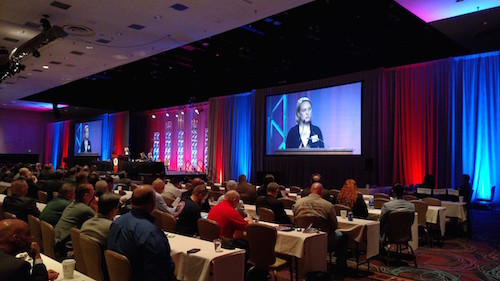More than 1,500 organizers, leaders and activists gathered in Las Vegas in mid-November for the Membership Development conference, the largest annual gathering of IBEW members.

|
| The November Membership Development conference brought together 1,500 IBEW members, leaders and organizers to look back at a year of successes and plan for a year challenges and opportunities.
|
The conference was the first large IBEW meeting since the November election saw the defeat of many IBEW supported candidates, and International President Lonnie Stephenson addressed that from the opening gavel.
“Last week was hard and a lot of you are asking, ‘What do we do now?’ Here’s what we do.” Stephenson said. “We organize like hell.”
The bulk of the conference was about re-connecting the IBEW’s army of organizers and sharing what they have learned in the last year’s campaigns. There was also a first-of-its-kind three-day new organizer training course was delivered to more than 110 newly-assigned local organizers.
A big part of the message Special Assistant to the International President for Membership Development Ricky Oakland wanted everyone to get was that there was a lot of good news about the IBEW.
“It’s everywhere you look,” he said.
For the third year in a row, the IBEW is growing. “A” membership –largely construction members, but open to all IBEW members-- is at a record high.
Organizing victories at Asplundh alone have brought in thousands of new members and, right before the conference kicked off, the IBEW scored one of the largest manufacturing wins in the right-to-work South in recent memory at Electrolux in Memphis, Tenn.
“If we can win there, I am not afraid of anybody,” Oakland said. “The challenges have been and will certainly be formidable, but there is good news: our future is in our hands and always has been. And the IBEW is growing.”
Laws may change, Oakland said. At least three states –New Hampshire, Kentucky and Missouri—are expected to pass some kind of right-to-work legislation. But Stephenson and Oakland laid out a strategy to not only keep the IBEW growing, but accelerate the growth to meet the targets set at the 39th IBEW Convention in September.
First, Oakland said, the IBEW will ramp up internal organizing, targeting people the IBEW already represents, who benefit from collective bargaining agreements and representation but aren’t members.
“The low-hanging fruit,” Oakland called them.
“We know where the people are,” he said. “We already provide a service for them. We just need to convince them of the value of becoming a member.”
Next, Oakland said, the IBEW would focus in the coming years on companies whose workforce is already partially represented by IBEW locals. That could include manufacturers, contractors or utilities that have some nonunion workers and some IBEW members.
“It is simpler to prove the value of being a member if we already have relationships with workers. We just point to the wages and benefits our members get and ask the nonunion workers how their paychecks compare,” he said. “We are also less likely to get all out resistance if the company already has managers that can see the value of having IBEW members in their workforce.”
With unemployment rate falling below 5 percent in early December, Stephenson said there was an opportunity for the IBEW they haven’t seen since the `90s. U.S. workers are quitting their jobs at the fastest rate since 2007, he noted.
“If workers are becoming confident enough to quit their job to go find a better one, they might also be more likely to stay and try to make their job better as well,” Stephenson said. “The truth is, a lot of workers today would gladly join a union, but many, especially younger ones who just entered the workforce, don’t even know what one is.”
So while Republicans may make it harder for unions to do their jobs, people who work for a living are asking questions that organized labor can answer.